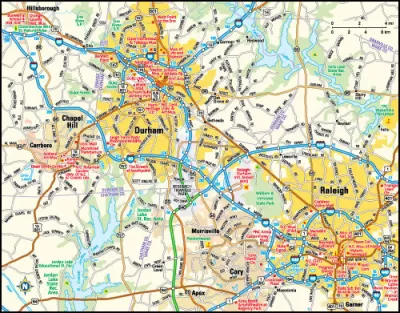This week residents in the North Carolina Triangle (Raleigh-Durham-Chapel Hill) will provide input on key segments of a future regional light rail system. The project has been analyzed for 15 years, yet the question of whether to build it remains.

NC planners ask: Where to build light rail (and should we still do it?)
This week residents in the North Carolina Triangle (Raleigh-Durham-Chapel Hill) will provide input on key segments of a future regional light rail system. The project has been analyzed for 15 years and is now partially funded, yet the question of whether to build it still remains.
In a series of public workshops, Triangle Transit—lead agency for the proposed 51 mile system—will seek input on specific route configurations, and among the issues are where to locate station areas and maintenance facilities, which neighborhoods to serve, and how to avoid impacting streams and wetlands.
So why are they also asking whether to build the system at all? The system is estimated at $1.34 billion, which may be contribute to lingering doubt. Several Metropolitan Planning Organizations collaborated to help develop Triangle's future transit vision, which includes increased local bus service, expanded regional bus service, and light rail. The system would serve three counties, and almost two dozen cities, as well as several major employment centers, colleges, and the Raleigh-Durham International Airport. The 3000 square mile service area includes 1.5 million residents—approximately 13% of North Carolina's statewide population—and is expected to grow to 2.5 million by 2035.
The regional transit vision relies on new revenue sources, and some local funding is already in place via sales taxes and vehicle registration fees. However a comprehensive, long-term financing strategy with state and federal support has not been secured.
In their workshops this week, Triangle Transit continues to move the project forward, working to resolve key routing questions and asking a question still on everyone's mind: Should we build it?
FULL STORY: Public comments will help fix Orange-Durham light rail route

Planetizen Federal Action Tracker
A weekly monitor of how Trump’s orders and actions are impacting planners and planning in America.

Congressman Proposes Bill to Rename DC Metro “Trump Train”
The Make Autorail Great Again Act would withhold federal funding to the system until the Washington Metropolitan Area Transit Authority (WMATA), rebrands as the Washington Metropolitan Authority for Greater Access (WMAGA).

The Simple Legislative Tool Transforming Vacant Downtowns
In California, Michigan and Georgia, an easy win is bringing dollars — and delight — back to city centers.

The States Losing Rural Delivery Rooms at an Alarming Pace
In some states, as few as 9% of rural hospitals still deliver babies. As a result, rising pre-term births, no adequate pre-term care and "harrowing" close calls are a growing reality.

The Small South Asian Republic Going all in on EVs
Thanks to one simple policy change less than five years ago, 65% of new cars in this Himalayan country are now electric.

DC Backpedals on Bike Lane Protection, Swaps Barriers for Paint
Citing aesthetic concerns, the city is removing the concrete barriers and flexposts that once separated Arizona Avenue cyclists from motor vehicles.
Urban Design for Planners 1: Software Tools
This six-course series explores essential urban design concepts using open source software and equips planners with the tools they need to participate fully in the urban design process.
Planning for Universal Design
Learn the tools for implementing Universal Design in planning regulations.
Smith Gee Studio
City of Charlotte
City of Camden Redevelopment Agency
City of Astoria
Transportation Research & Education Center (TREC) at Portland State University
US High Speed Rail Association
City of Camden Redevelopment Agency
Municipality of Princeton (NJ)





























